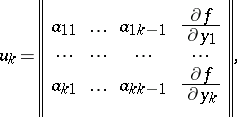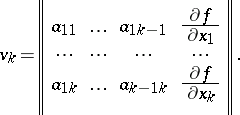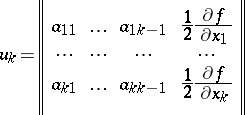Jacobi method
A method for reducing a quadratic form (cf. also Quadratic forms, reduction of) to canonical form by using a triangular transformation of the unknowns; it was suggested by C.G.J. Jacobi (1834) (see [1]).
Let
 |
be a given bilinear form (not necessarily symmetric) over a field  . Suppose that its matrix
. Suppose that its matrix  satisfies the condition
satisfies the condition
 | (1) |
where  is the minor of order
is the minor of order  in the upper left-hand corner. Then
in the upper left-hand corner. Then  can be written in the form
can be written in the form
 | (2) |
where  ,
,  , and for
, and for  ,
,
 | (3a) |
 | (3b) |
In particular, if  is a symmetric matrix satisfying (1) and
is a symmetric matrix satisfying (1) and  is the quadratic form with matrix
is the quadratic form with matrix  , then
, then  can be reduced to the canonical form
can be reduced to the canonical form
 | (4) |
by using the following transformation of the unknowns:
 | (5) |
for  , and
, and
 |
This transformation has a triangular matrix, and can be written as
 | (6) |
where  is the minor of
is the minor of  that stands in the rows
that stands in the rows  , and in the columns
, and in the columns  .
.
The formulas (2)–(7) are called Jacobi's formulas.
When the matrix of  satisfies only the conditions
satisfies only the conditions
 |
 |
where  is the rank of the form,
is the rank of the form,  can be reduced to the canonical form
can be reduced to the canonical form
 | (7) |
(here  ) by a triangular transformation of the unknowns. This reduction can be realized by using the Gauss method (see [1]). If, in particular,
) by a triangular transformation of the unknowns. This reduction can be realized by using the Gauss method (see [1]). If, in particular,  , then the positive index of inertia of
, then the positive index of inertia of  is equal to the number of preservations of sign, and the negative index of inertia is equal to the number of changes of sign in the series of numbers
is equal to the number of preservations of sign, and the negative index of inertia is equal to the number of changes of sign in the series of numbers
 |
See also Law of inertia.
References
| [1] | F.R. [F.R. Gantmakher] Gantmacher, "The theory of matrices" , 1 , Chelsea, reprint (1977) (Translated from Russian) |
I.V. Proskuryakov
Jacobi's method is a one-step iteration method (cf. Simple-iteration method) for solving a system of linear algebraic equations  for which a preliminary transformation to the form
for which a preliminary transformation to the form  is realized by the rule:
is realized by the rule:
 |
 |
G.D. Kim
Comments
Alternative names occurring in Western literature for this iteration method are: Gauss–Jacobi iteration, point Jacobi iteration, method of successive substitutions, and method of simultaneous displacements. It was already used by C.G.J. Jacobi (1845) (see [a3]). If the matrix  is irreducibly diagonally dominant, then the method converges for any starting vector (cf. [a1]). With the introduction of new computer architectures such as vector and parallel computers, Jacobi's method has regained interest because it vectorizes and parallelizes extremely well. Comprehensive surveys of related iterative methods for sparse matrix equations can be found in [a2], [a4], [a5], and [a6].
is irreducibly diagonally dominant, then the method converges for any starting vector (cf. [a1]). With the introduction of new computer architectures such as vector and parallel computers, Jacobi's method has regained interest because it vectorizes and parallelizes extremely well. Comprehensive surveys of related iterative methods for sparse matrix equations can be found in [a2], [a4], [a5], and [a6].
References
| [a1] | L. Collatz, "Ueber die Konvergentzkriterien bei Iterationsverfahren für lineare Gleichungssysteme" Math. Z. , 53 (1950) pp. 149–161 |
| [a2] | L.A. Hageman, D.M. Young, "Applied iterative methods" , Acad. Press (1981) |
| [a3] | C.G.J. Jacobi, "Ueber eine neue Auflösungsart der bei der Methode der kleinsten Quadraten vorkommenden lineare Gleichungen" Astr. Nachr. , 22 : 523 (1845) pp. 297–306 |
| [a4] | J.M. Ortéga, "Numerical analysis" , Acad. Press (1972) |
| [a5] | R.S. Varga, "A comparison of the successive over-relaxation method and semi-iterative methods using Chebyshev polynomials" Siam J. Appl. Math. , 5 (1962) pp. 39–47 |
| [a6] | D.M. Young, "Iterative solution of large linear systems" , Acad. Press (1971) |
Jacobi's method is a rotation method for solving the complete problem of eigen values and eigen vectors for a Hermitian matrix.
G.D. Kim
Comments
The convergence of Jacobi's method has been examined by J. von Neumann and H. Goldstine (see [a1]). Related rotation (or: transformation) methods are Householder's method and Francis' QR method (cf. [a2]).
References
| [a1] | C.E. Fröberg, "Introduction to numerical analysis, theory and applications" , Benjamin/Cummings (1985) |
| [a2] | G.H. Golub, C.F. van Loan, "Matrix computations" , North Oxford Acad. (1983) |
Jacobi method. Encyclopedia of Mathematics. URL: http://encyclopediaofmath.org/index.php?title=Jacobi_method&oldid=13854